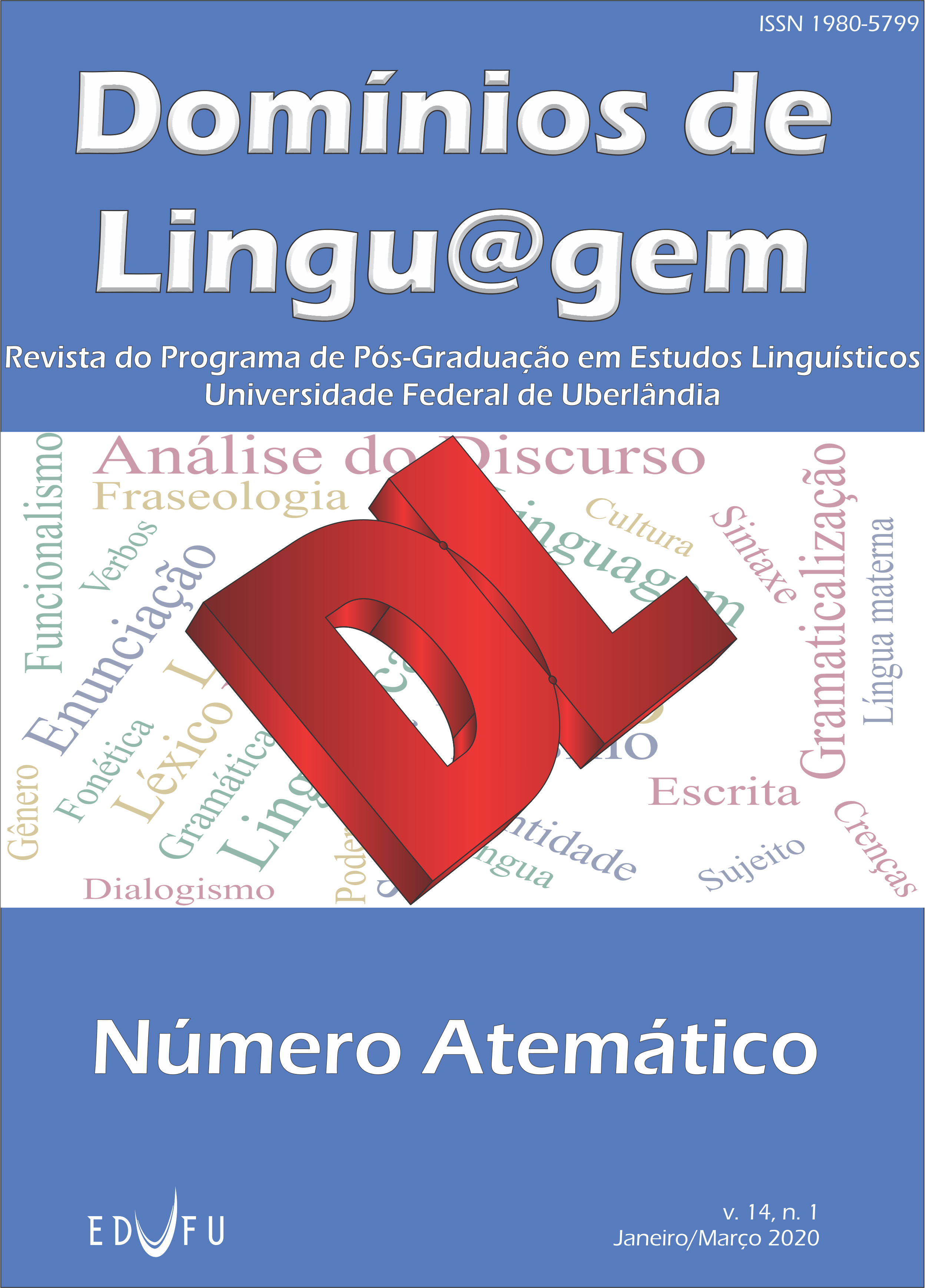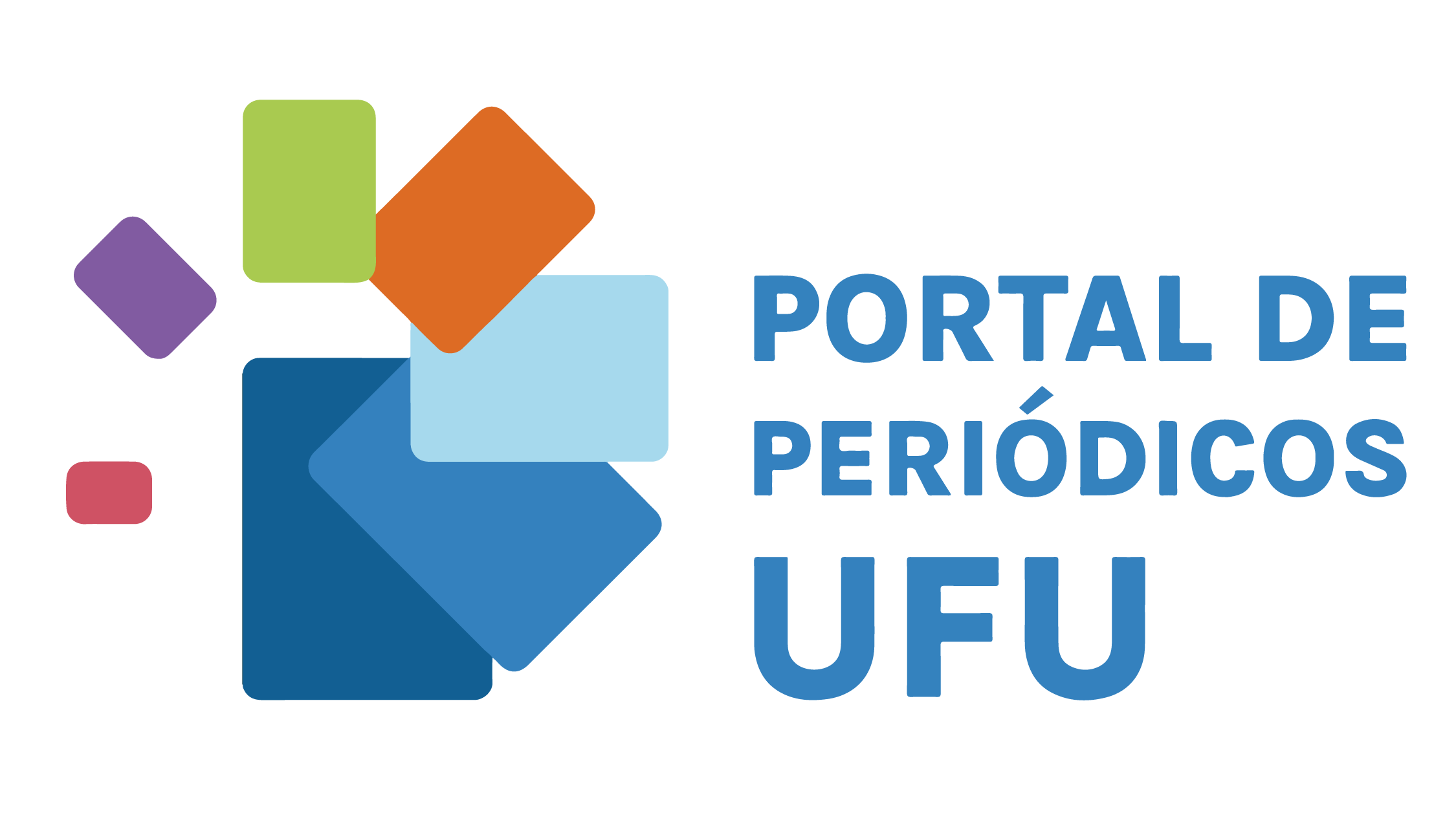The systematic characteristics of multimodal resources mobilized by a child with ASD in embodied turn-takings
DOI:
https://doi.org/10.14393/DL40-v14n1a2020-2Keywords:
Multimodal Analysis, Autism Spectrum Disorder, Complex Multimodal GestaltAbstract
This paper aims to analyze the multimodal resources (speech, gestures, objects and body movements) mobilized by Luiza, pseudonym of a child diagnosed with Autism Spectrum Disorder (ASD), and her family members during the process of joint attention in an everyday interaction in a non-institutional environment. To that end, we focus on approaches that emphasize the multimodal aspects of language, highlighting the fine articulation between verbal and gesture productions mobilized by this individual with ASD as linguistic forms that produce semantic and pragmatic structural complexity that may contribute for the studies on relations between gestures and grammar, in search of a Complex Multimodal (gesture/posture + speech) Gestalt (standard) in the communicative repertoire of this child. The findings of the analysis suggest that, although having some restrictions from the point of view of verbal resources, Luiza mobilizes them in articulated way to non-verbal resources to build and participate in the interactive-communicational situation. Therefore, the multimodal research made it possible to give visibility to a range of linguistic and gestural resources employed by this child.
Downloads
Metrics
References
ANDRADE, C. K. S. Linguagem e autismo: a multimodalidade no contexto escolar. 2017. 148 f. Dissertação (Mestrado em Linguística) – Centro de Ciências Humanas, Letras e Artes, Universidade Federal da Paraíba, João Pessoa, 2017.
AUBURN, T.; POLLOCK, C. Laughter and competence: children with severe autism using laughter to joke and tease. In: GLENN, P.; HOLT, E. Studies of laughter in interaction. London: Bloomsbury, 2013. p. 135-160.
AUER, P. On-line syntax: thoughts on the temporality of spoken language. Language sciences, v. 31, n. 1, p. 1-13, 2009. DOI https://doi.org/10.1016/j.langsci.2007.10.004.
AUER, P. The temporality of language in interaction: projection and latency. In: DEPPERMANN, A.; GÜNTHNER, S. D. (ed.). Studies in language and social interaction, v. 27, p. 27-56, 2015. DOI https://doi.org/10.1075/slsi.27.01aue.
BRAIT, B. O processo interacional. In: PRETI, D. (org.) Análise de textos orais. Humanitas: São Paulo, 2010.
COTS, C. P. Quando a linguagem verbal se ausenta, o que há? Relatório Final de Pesquisa. Fundação de Amparo à Pesquisa do Estado de São Paulo. Pesquisa Fapesp 14/15206-6, São Paulo, 2015.
COTS, C. P. Recursos interacionais multimodais mobilizados por uma criança com TEA em brincadeiras familiares. 2018. 141 f. Dissertação (Mestrado em Letras) – Escola de Filosofia, Letras e Ciências Humanas, Universidade Federal de São Paulo, Guarulhos, 2018.
CRUZ, F. M. Interação corporificada: multimodalidade, corpo e cognição explorados na análise de conversas envolvendo sujeitos com Alzheimer. Alfa, São Paulo, v. 61, n. 1, p. 55-80, 2017a. DOI https://doi.org/10.1590/1981-5794-1704-3.
CRUZ, F. M. Elementos para uma análise multimodal da interação: um exemplo de correlação linguístico-gestual no autismo. In: Multimodalidade nos estudos discursivos. Trabalho apresentado no VIII EPED (Encontro de Pós-graduandos Universidade de São Paulo/USP), p. 158-179, 2017b.
CRUZ, F. M. Documentação e investigação multimodal de interações envolvendo crianças com autismo: corpo, linguagem e mundo material. Revista Calidoscópio Unisinos, São Leopoldo, v. 16, n. 2, p. 179-193, mai/ago, 2018. DOI https://doi.org/10.4013/cld.2018.162.01.
DELFRATE, C. B.; SANTANA, A. P. O.; MASSI, G. A. A aquisição de linguagem na criança com autismo: um estudo de caso. Psicologia em estudo, Maringá, v. 14, n. 2, p. 321-331, abr./jun, 2009. DOI https://doi.org/10.1590/S1413-73722009000200013.
DINDAR, K.; KORKIAKANGAS, T.; LAITILA, A.; KÄRNÄ, E. Facilitating joint attention with salient pointing in interactions involving children with autism spectrum disorder. Gesture, v. 15, n. 3, p. 372-403, 2016. DOI https://doi.org/10.1075/gest.15.3.06din.
ENFIELD, N. The body as a cognitive artifact in inship representations: hand gesture diagrams by speakers of Lao. Current Anthropology, v. 46, n.1, p. 1-26, 2005.
FENG, H. Studying eye gaze of children with autism spectrum disorders in interaction with a social robot. 2014. 112 f. Thesis (Degree master of Science) – Faculty of the Daniel Felix Ritchie School of Engineering and Computer Science, University of Denver, Denver, 2014. Disponível em:
https://digitalcommons.du.edu/cgi/viewcontent.cgi?article=1192&context=etd. Acesso em: 31 mar. 2019.
GLENN, P. Laughter in interaction. New York: Cambridge University Press, 2003. DOI https://doi.org/10.1017/CBO9780511519888.
GOODWIN, C. Conversational organization: interaction between speakers and hearers. New York: Academic Press, 1981.
GOODWIN, C. Things and their embodied environments. In: LAMBROS, M.; RENFREW, C. (ed.). The cognitive life of things: recasting boundaries of the mind. Cambridge, UK, McDonald Institute for Archaeological Research, 2010. p. 103–120.
GRANDIN, T. Thinking in pictures: and other reports from my life with autism. New York: Vintage Books, 1996. 240 p.
JEFFERSON, G. A technique for inviting laughter and its subsequent acceptance declination. In: PSATHAS, G. (ed.). Everyday language: studies in ethnomethodology. New York: Irvington, 1979. p. 79–96.
KENDON, A. Gesture: visible actions as utterance. Cambridge: Cambridge University Press, 2004. DOI https://doi.org/10.1017/CBO9780511807572.
KLEPPA, L. Estruturas de tópico-comentário na fala reduzida de um sujeito afásico. Estudos linguísticos, São Paulo, v. 43, n. 2, p. 926-939, maio-ago. 2014.
KORKIAKANGAS, T.; RAE, J. The interactional use of eye-gaze in children with autism spectrum disorders. Interaction studies, v. 15, n. 2, p. 233-259, 2014. DOI https://doi.org/10.1075/is.15.2.12kor.
LAI, M. C.; LOMBARDO, M.; BARON-COHEN, S. Autism. The lancet, v. 383, n. 9920, p. 896-910, 2014. DOI https://doi.org/10.1016/S0140-6736(13)61539-1.
LEVINSON S. C.; HOLLER J. The origin of human multi-modal communication. Philosophical. Transactions of the Royal Society, v. 369, n. 1651, 2014. DOI https://doi.org/10.1098/rstb.2013.0302.
LIMA, C. V.; REHBERG, L. L. A multimodalidade da linguagem e os transtornos do espectro do autismo (TEA) num contexto terapêutico semidirigido. In: CAETANO, S.; LIMA-HERNANDES, M. C.; PAULA, F.; RESENDE, B. D.; MÓDOLO, M. (org.). Autismo, linguagem e cognição. 1. ed. Jundiaí: Paco Editorial, 2016. v. 1, p. 57-82.
MIGUENS, S. Conceito de crença, triangulações e atenção conjunta. In: MIGUENS, S.; MAURO, C. E. E. (ed.). Perspectives on rationality, Porto, Universidade do Porto - Faculdade de Letras, p. 99-118, 2006.
MONDADA, L. A referência como trabalho interativo: a construção da visibilidade do detalhe anatômico durante uma operação cirúrgica. In: KOCH, I. V.; MORATO, E. M.; BENTES, A. C. (org.). Referenciação e discurso. São Paulo: Contexto, 2005. p. 11-31.
MONDADA, L. Organisation multimodale de la parole-en-interaction: pratiques incarnées d’introduction des referents. Langue française, n. 175, p. 129-147, 2012. DOI https://doi.org/10.3917/lf.175.0129. Disponível em: https://www.cairn.info/revue-langue-francaise-2012-3-page-129.htm. Acesso em: 31 mar. 2019.
MONDADA, L. The local constitution of multimodal resources for social interaction. Journal of pragmatics, v. 65, p. 137–156, 2014a. DOI https://doi.org/10.1016/j.pragma.2014.04.004. Disponível em: https://www.sciencedirect.com/science/article/abs/pii/S0378216614000794?via%3Dihub. Acesso em: 31 mar. 2019.
MONDADA, L. Pointing, talk, and the bodies: reference and joint attention as embodied interactional achievements. In: SEYFEDDINIPUR, M.; GULLBERG, M. (org.). From gesture in conversation to visible action as utterance: Essays in honor of Adam Kendon. London: John Benjamins Publishing Company, 2014b. p. 95-124. DOI https://doi.org/10.1075/z.188.06mon.
MONDADA, L. Challenges of multimodality: Language and the body in social interaction. Journal of Sociolinguistics, v. 20, n. 3, 2016. DOI https://doi.org/10.1111/josl.1_12177. Disponível em: https://onlinelibrary.wiley.com/doi/full/10.1111/josl.1_12177. Acesso em: 31 mar. 2019.
SELTING, M. The construction of units in conversational talk. In: SELTING, M. Language in society, Cambridge University Press, v. 29, p. 477-517, 2000. DOI https://doi.org/10.1017/S0047404500004012.
SELTING, M. Syntax and prosody as methods for the construction and identification of turn-constructional units in conversation. In: SELTING, M.; HAKILINEN, A. (ed.). Syntax and lexis in conversation. Amsterdam: John Benjamins, 2005. p. 17-44. DOI https://doi.org/10.1075/sidag.17.04sel.
TOMASELLO, M. Joint attention as social cognition. In: MOORE, C.; DUNHAM, P. J. (ed.). Joint attention: its origins and role in development. Hillsdale, NJ: Erlbaum, 1995. p. 103-130.
TOMASELLO, M. Why we cooperate. Cambridge: MIT Press, 2009. DOI https://doi.org/10.7551/mitpress/8470.001.0001.
Downloads
Published
How to Cite
Issue
Section
License
Authors who publish in this journal agree to the following terms:
Authors retain the copyright and waiver the journal the right of first publication, with the work simultaneously licensed under the Creative Commons Attribution License (CC BY-NC-ND 4.0), allowing the sharing of work with authorship recognition and preventing its commercial use.
Authors are authorized to take additional contracts separately, for non-exclusive distribution of the version of the work published in this journal (publish in institutional repository or as a book chapter), with acknowledgment of authorship and initial publication in this journal.









